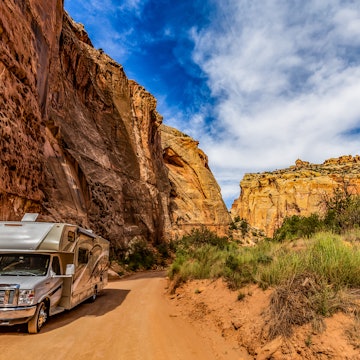

It may be the birthplace of the automobile but some parts of Michigan don't welcome them! © David Prahl / Getty Images
Michigan may be the birthplace of the automobile, but that doesn't mean it's the only way to navigate the Wolverine State.
Getting around the Great Lakes State could be as simple as hopping into a Chevy, but you can also bike through the streets of Detroit, explore car-free Mackinac Island on foot and catch a boat to the rural Upper Peninsula.
Whether you choose to travel by land or lake, here’s a guide to getting around Michigan.

Renting a car or an RV lets you hit the open road
It’s no surprise that the home state of Detroit – known as Motor City – is car-friendly. With 13 mainline highways crisscrossing throughout Michigan, it’s easy to take a road trip from one end of the state to the other. Cars are the most straightforward way to reach remote areas, but the costs of rental fees, gas prices, insurance and parking can add up.
With expansive stretches of wilderness, thousands of campgrounds and more than 100 state parks, many travelers choose to rent RVs for better access to nature.
Through the Pure Michigan Byways Program, visitors can plan driving routes along 23 State and National tour routes. Each Byway is outlined by scenic stops, natural wonders, historical sites and other cultural attractions. Byways are carefully mapped by destination, and detailed information such as duration of drive and travel restrictions are included in the online Byways driving guide.
How to get around Detroit on public transportation
Detroit has the most diverse transport options of any city in Michigan. It has the largest bus system in the state, plus a streetcar called the Qline. The city also has a bike-sharing program called MoGo as well as the People Mover, an elevated light rail train.
The People Mover is the state’s only inner-city metro system. It's cheap to ride and follows a one-way loop through downtown. It is often maligned by daily commuters for its lack of utility, but for travelers, it’s a fun way to get between downtown attractions such as Greektown and the Book Cadillac Building.
Grab a taxi in Michigan's cities
Taxi and ride-hailing apps such as Uber and Lyft operate throughout most of the state. Rates and availability vary depending on the area. The Detroit and Ann Arbor metro areas have the highest volume of cab companies bookable by phone or online.
Other areas of the state have transport companies that cater to tourists, like the Wine Country Limo and Trolley Service in Traverse City or Gough Carriages, horse-drawn buggies serving car-free Mackinac Island.
Tips for finding a taxi: Cabs are not as plentiful in Michigan cities as they are in places like Chicago or New York City. It is recommended that you call ahead to book a taxi. Apps like Checker in Detroit can help you connect with a reputable cab service to book in advance. Riders receive a fare estimate and an email or text confirmation.

Sail across the Great Lakes State by boat
Bordered by four of the five Great Lakes and home to over 60,000 inland lakes and ponds, Michigan is a boater’s dream. Ferries are a popular way to reach secluded destinations like Harsens Island or Round Island (accessible only by boat), as well as an opportunity to take in the beauty of the Great Lakes.
Ferry services such as the Lake Express High Speed Ferry and the S.S. Badger operate across Lake Michigan, connecting Michigan to Wisconsin. Other destinations such as Mackinac Island have several waterway options, including the Star Line Ferry and Shepler’s Ferry.
Water taxis and boat tours provide family-friendly excursions along inland bodies of water and around the Great Lakes. Local tourist offices and welcome centers throughout the state can provide helpful information on these options in each area.
Some ferry systems and boat tours are available only during certain seasons. Check that the ferries are operating before planning any travel by boat.
Book a flight if you're crunched for time
Though flying is never the sustainable choice, for longer journeys in Michigan, air travel can sometimes be the more efficient option and, depending on the expense of a rental car or RV, more economical. Some destinations, such as Beaver Island or Mackinac Island, can only be reached by boat or plane, and more remote places in the Upper Peninsula, such as Marquette and Copper Harbor, are better accessed by regional airports.
Don't forget to factor in downtime in the airport versus highway traffic and ferry timetables to find the fastest route.

The bus is a great budget-friendly option
Long-distance buses are the cheapest form of travel throughout Michigan, and major lines can take passengers from the southern shores to the tip of the Upper Peninsula. The main bus companies are Greyhound, Indian Trails and Megabus. Greyhound provides the most comprehensive service, with 47 bus stops within the state.
Michigan has three train routes
Amtrak serves Michigan through three train lines that originate in Chicago. The Blue Water line passes through Flint, Lansing and Kalamazoo, and the Pere Marquette line stops in St Joseph, Holland and Grand Rapids. The third line – the Wolverine – is a high-speed train that runs between Chicago and Pontiac. It reaches speeds of up to 110mph and stops in Ann Arbor and Detroit.
While trains can be the most efficient form of transport within Michigan, it’s wise to check other options. Direct bus routes can sometimes be faster and cheaper, depending on your destination.
Accessible transportation in Michigan
For travelers with access needs, Michigan can be difficult – but not impossible – to navigate. Transit systems in cities such as Detroit and Flint have wheelchair-accessible buses, and some cities offer curb-to-curb transit that can be scheduled in advance. However, to use this complimentary service, an application must be filled out in each metropolitan area, which can get complicated depending on the number of destinations on your itinerary.
The Michigan Disability Network has a helpful directory that provides useful information, organized by region, for those with disabilities.
For long-distance travel, most buses and trains can accommodate riders with disabilities. When riding the Greyhound, it is recommended that you notify the company if you require wheelchair accessibility or other services. If traveling on Amtrak, passengers can make specific requests for accessible service.
Under Michigan law, service animals are welcome at all “public accommodations” throughout the state, meaning that all transit services in Michigan must allow service animals on board.
















